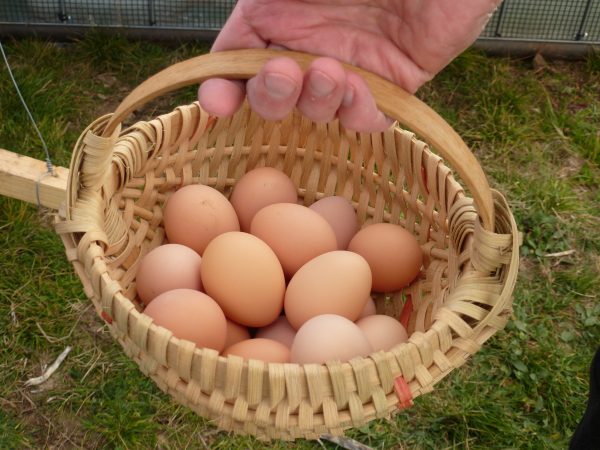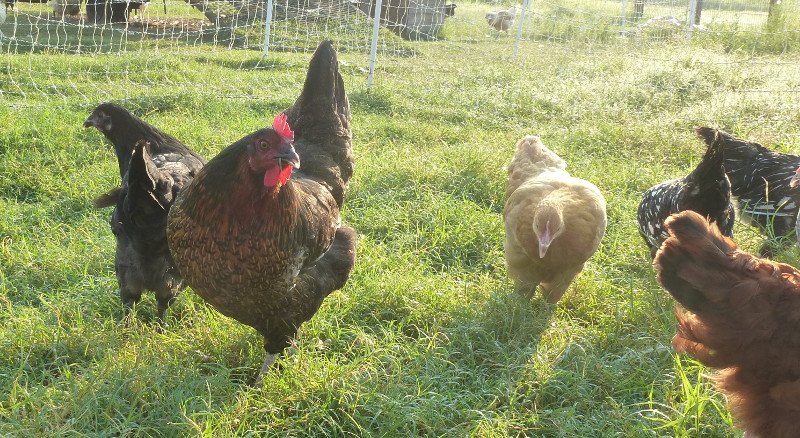Raising chickens for fresh eggs at home has many benefits, but it also takes a bit more planning than buying eggs at the store.
In this post, I'll go over how to estimate the number of hens that you need in your flock.

1. First estimates
If you haven't raised chickens previously, I recommend following along with the guidelines below to determine the size of your first flock. Once your flock begins laying, you'll soon get an idea as to whether you have too many or too few, and you can adjust from there.
This is the same approach that I take with our family garden. There are crop charts and such that tell how many pounds of garden produce you can expect from so many square feet of garden beds or from so many "row feet" of garden space, but these are only estimates. Weather, watering, soil fertility and lots of other variables outside your control will ultimately affect your yield. So we start out with an estimate, then adjust. Did we get too many yellow crookneck squash last year? How many did we plant? 6 plants. Let's reduce it to 4 this year. Not enough green beans? We planted 100 square foot bed? Let's raise 150 square feet this year. And so on.
With your chickens, lots of variables will play in to how many eggs you will get from them. Which breed you select, the age of the birds, climate, lighting, stress, nutrition, coop conditions and such all play a part.
2. How many eggs do I need per week?
In estimating how many chickens to get, first off, you'll need to know how many eggs you want or need. For planning like this, I like to think in terms of eggs per week. A week is long enough to "smooth out" some of the day to day variations and give you a better estimate, and it's a convenient unit of time to work with.
You may already have some idea or even a pretty accurate idea of how many eggs you use each week. If so, I'd recommend just going with that estimate. If you aren't sure, then you could just keep track of how many eggs are eaten in your household for a week, then think back over the week and ask yourself if that was a typical week or not. Adjust the number of eggs up or down, as
appropriate, and use that as a starting point. Again, this is all just an estimate that you'll later adjust as you start raising your flock.
I'm sure there's a lot of variation from one family to the next depending on personal food preferences, nutritional requirements and many other considerations, but just as a point of reference, our family of 6 uses about 2 dozen eggs a week. One or two of us will have eggs for breakfast nearly every day, and we'll occasionally make banana bread or some other dessert during the week that uses a few more eggs. Generally, 24 eggs a week seems about right for us.
3. How many eggs will my chickens lay per week?
Now that we have an estimate for number of eggs needed per week, the next consideration is: how many eggs a week will your hens lay, on average? Depending on what breed you choose, that number can vary a lot.
The best laying breeds, such as White Leghorns, Red Stars, Black Stars, Black Australorps and Rhode Island Reds can lay 250 to 300 eggs per year during their first year of laying, possibly more. (Based on a little research, I've found that 371 eggs in 364 days is considered the record.) A number of other breeds will lay less. Most good layers will lay upwards of 200 eggs a year for their first year.
As your hens grow older, they will gradually lay less. By the time your hens are 10 years old, they won't lay much at all. Here, we'll plan for 1-2 years of laying, so I'll focus on the time period when the hens are still fairly productive.
4. Egg Budget
I like to budget somewhat conservatively because I would rather have extra eggs at the end of the day that I can give to a neighbor, and my wife will often cook up excess eggs into a recipe that uses a lot of eggs, such as Jalapeno Cheese snacks. I'd much rather that than to have to pick up a dozen eggs at the grocery store. Plus, in our home flock, some of our hens have been laying for longer than a year, so their productivity has begun to decline some.
I'll estimate based on 200 eggs per hen per year. 200/365 = 0.55 eggs per chicken per day. Rounding this off makes the math a little simpler. I'll just use the figure that 1 hen lays about 1/2 egg a day (or more sensibly, we can expect 1 egg a day for every two hens). If you prefer to be less conservative in your estimates, then you may want to plan on 250 or even 300 eggs per year, but the basic arithmetic works the same.
5. Estimating the number of chickens needed
Based on the 0.5 eggs per chicken per day figure, if we need 24 eggs per week, as estimated above, then 24/7 = 3.4 eggs needed per day. 3.4 eggs per day divided by 0.5 eggs per chicken = 3.4 / 0.5 = 6.8, or approximately 7. So we would need about 7 hens to produce 24 eggs a week somewhat reliably.
Being that this is a somewhat conservative estimate, most of the time, we'll be getting more than 24 eggs a week. And during the months when they don't lay as well due to weather or shorter day lengths during winter, we'll still, hopefully, be close to our target. If they stop laying, or we get fewer eggs than we need, there are a few things to look at, but that will be the topic of another article.
6. Table for estimating how many hens you need
To make it really simple to determine how many hens you'll need, I've included a table below. To use it, first estimate how many eggs a week you'll need. Next, decide if you want to base your estimates on 200, 250 or 300 eggs per hen per year, and look under that column in the table. The numbers within the table tell you approximately how many eggs to expect per week on average from your flock. Find the number that most closely corresponds to the number of eggs that you need, based on your estimate, then look down that row to the left to see how many hens you would need.
If you need more eggs per week than the numbers shown in the table, you can scale it up by multiplying by 10. So, for example, if you needed 350 eggs per week and your hens lay 200 eggs a year each, then you would need 90 hens.
| 1 | 4 | 5 | 6 |
| 2 | 8 | 10 | 12 |
| 3 | 12 | 14 | 17 |
| 4 | 15 | 14 | 23 |
| 5 | 19 | 24 | 29 |
| 6 | 23 | 29 | 35 |
| 7 | 27 | 34 | 40 |
| 8 | 31 | 38 | 46 |
| 9 | 35 | 43 | 52 |
Started Pullets
Year-round, we have a variety of started pullets for sale that are close to laying age. We ship Started Pullets to most of the United States.

